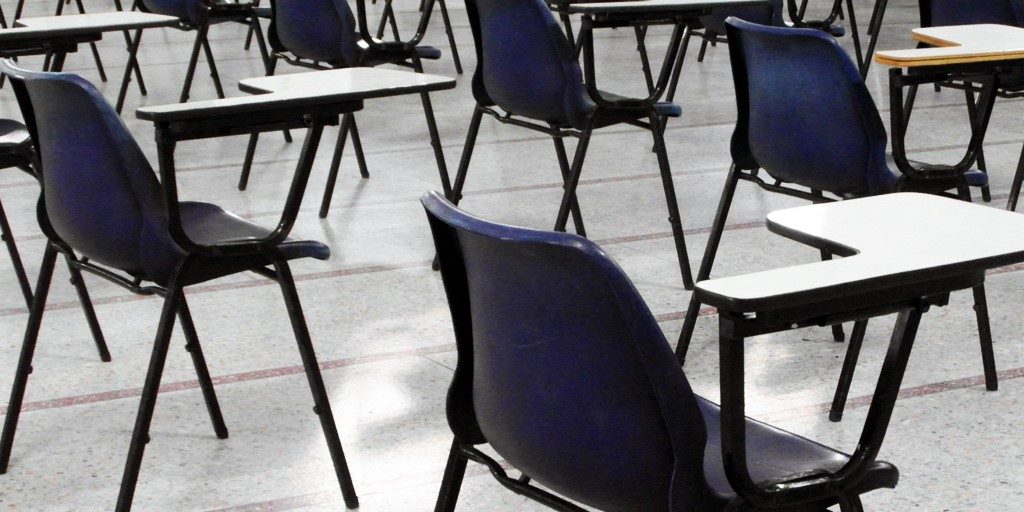On Tuesday 17 April, the Cabinet Secretary for Education, Kirsty Williams, is scheduled to make a statement in Plenary providing an update and outline of next steps for the Welsh Government’s Pupil Development Grant (PDG). The PDG is also currently the subject of an Assembly Committee inquiry (the Children and Young People Committee) into Targeted Funding to Improve Educational Outcomes. Kirsty Williams recently provided written (9 March, PDF 1.23MB) and oral (22 March) evidence to the Committee’s inquiry.
The PDG is one of the Welsh Government’s flagship education policies and aims to tackle the impact of deprivation and disadvantage on educational outcomes. With an annual budget of £94 million, the PDG accounts for 6% of the Welsh Government’s Education revenue budget (although note that core funding for schools comes out of the Local Government budget so it would be a smaller proportion when this is also counted). The Cabinet Secretary changed the name of the PDG from the ‘Pupil Deprivation Grant’ to the ‘Pupil Development Grant’ in April 2017, although confirmed that it would retain the same emphasis on pupils from deprived backgrounds (in answer to WAQ73368 in April 2017 and in the CYPE Committee on 14 June 2017 (PDF 340KB)).
Who is eligible for the PDG and how much is paid?
The PDG was introduced in financial year 2012-13. It provides extra money to schools based on the number of pupils eligible for free school meals (eFSM) on their roll. £1,150 is paid per eFSM pupil in Years 1-11, making up £77 million of the £94 million budget.
In 2015-16, the PDG was extended to Early Years (3-5 year olds: up to and including Reception year) on the basis of £300 per eligible child. This rose to £600 in 2017-18 and has subsequently increased to £700 for 2018-19. Around £9.5 million is allocated to the Early Years PDG.
Estyn has reported (PDF 383KB) that around two thirds of school use their PDG allocations effectively, which the inspectorate contextualised as also being approximately the proportion of schools that have good leadership in general. Some analysis of eFSM pupils’ attainment is provided later in this article.
The PDG is also payable in terms of eFSM children educated otherwise than at school (EOTAS), at a cost of slightly over £1 million.
Finally, the PDG also provides money to regional consortia to be spent on looked after children and adopted children, also on the basis of £1,150 per child. £4.6 million is allocated to the four consortia in 2018-19 on the basis of 4,037 children registered as looked after. The Welsh Government’s website provides details of PDG allocations in 2018-19.
Each consortium now has a strategic adviser for the PDG, although evidence to the CYPE Committee’s Targeted Funding to Improve Educational Outcomes inquiry suggests that a strategic approach to the looked after children element of the PDG has only recently been developed. It has also highlighted the limitations in targeting the PDG at adopted children in particular. This is an area the Welsh Government has said it wants to improve and the Cabinet Secretary has described the most recent statistics on looked after children’s attainment as ‘extremely disappointing’.
In November 2017, the Welsh Government commissioned ICF Consulting to evaluate the looked after children PDG, with its report expected to be published before the summer 2018 recess.
What impact has the PDG had on eFSM pupils’ attainment?
The gap between eFSM pupils’ and non FSM pupils’ attainment has narrowed in recent years. However, as the evaluation of the PDG by Ipsos MORI and WISERD (published December 2017) highlighted, this trend started before the PDG’s introduction and it is difficult to discern how much can be directly attributed to the grant funding itself. Data and analysis can be found in our Research Briefing, Key Stage 4 Attainment Data, although a summary is given below.  According to the main performance measure used by the Welsh Government up to now – the Level 2 threshold inclusive (5 or more GCSEs at grades A*-C, including Maths and English/Welsh, or the vocational equivalent) – the eFSM/nonFSM attainment gap narrowed from 33.9 percentage points in 2010 to 31.2 percentage points in 2016. When any 5 GCSEs at grades A*-C are counted (the Level 2 threshold measure), the gap reduced from 34.3 percentage points in 2010 to 17.4 percentage points in 2016.
According to the main performance measure used by the Welsh Government up to now – the Level 2 threshold inclusive (5 or more GCSEs at grades A*-C, including Maths and English/Welsh, or the vocational equivalent) – the eFSM/nonFSM attainment gap narrowed from 33.9 percentage points in 2010 to 31.2 percentage points in 2016. When any 5 GCSEs at grades A*-C are counted (the Level 2 threshold measure), the gap reduced from 34.3 percentage points in 2010 to 17.4 percentage points in 2016.
However, the eFSM/nonFSM attainment gap widened in 2017 after years of sustained progress in narrowing it. For the Level 2 threshold inclusive it widened to 32.4 percentage points, whilst for the Level 2 threshold it almost doubled to 32.3 percentage points. It is generally considered that the Welsh Government’s changes to how the Level 2 threshold and Level 2 threshold inclusive measures are recorded (with less recognition of vocational qualifications) have affected eFSM pupils to a greater extent than other pupils.
The Cabinet Secretary told the CYPE Committee on 22 March 2017:
So, if you look at it—with the usual caveats about whether you can make direct comparisons on level 2 plus between the exams the year before and the exams that we had last summer—on the face of it, the gap has increased. (…)
I think there's no one answer to why free-school-meal children were not so resilient last year. We continue to have discussions with Qualifications Wales to get a better understanding of this. At my next ministerial policy board, in May, we'll be doing a deep dive into this particular subject.
The PDG for more able and talented eFSM pupils
It has been recognised for some time that the Welsh education system needs to improve the way it stretches more able and talented pupils and how they are supported in fulfilling their potential and achieving the highest grades. The Cabinet Secretary has announced the extension of the Seren Network to GCSE pupils and £3 million funding to support more able and talented pupils.
In terms of the PDG, Kirsty Williams has already reiterated to schools that the grant is for all eligible pupils and not only for those at risk of low attainment. In her letter to schools (PDF 206KB) accompanying the announcement of 2018-19 PDG allocations, Kirsty Williams wrote:
I want to be clear the PDG supports all eligible learners including our most able learners. To be truly equitable and excellent we must ensure that all pupils are supported to reach their full potential.
This follows evidence received by the CYPE Committee’s Targeted funding to improve educational outcomes inquiry – including from WISERD, which jointly evaluated the programme, and Estyn – indicating that schools are blurring disadvantage with low attainment and insufficiently using the PDG on eFSM pupils who have the potential to achieve the highest grades. WISERD’s Professor Chris Taylor referred to a ‘blurring of the targeted intervention to mitigate disadvantage with the wider school improvement funding and grants and priorities, explaining:
Consequently, schools were using their money to raise low attainment, not necessarily raising the attainment of all children who are from disadvantaged backgrounds, which is kind of a fundamental misunderstanding of the conceptual basis of the policy. (…)
The point of the policy was to mitigate the structural inequalities that some of these children experienced living in poverty. It doesn't matter what their levels of attainment are; they can be high-achieving pupils, for all I care. They also ought to receive the benefit, because the argument is that they should be doing better than where they are now. And I think schools have not really grasped that, partly again because there are other priorities in the school, particularly for many schools about raising levels of attainment.
Estyn has written that ‘very few’ schools have used the PDG to support disadvantaged pupils who are more able and that this is ‘rarely a central aspect’ of schools’ PDG plans. HM Chief Inspector of Education and Training in Wales, Meilyr Rowlands, told the CYPE Committee:
So, if there is a cohort of pupils who are missing out on this, they are the more able and talented pupils who receive free school meals. There are a number of reasons for this, I think. One of them is that there’s still some feeling that less able children should be receiving this grant, children who are underachieving. Schools don’t always identify underachievement of those more able children. It seems that they are doing okay, but if they were given more support, they would do even better.
Greater flexibility and a commitment for the next two years
Two of the other themes emerging from the CYPE Committee’s Targeted funding to improve educational outcomes inquiry, which the Welsh Government has since sought to address, are:
- a need for greater flexibility in which pupils schools can target the PDG at, for example a pupil may be eFSM on school census day one year but not eFSM at the time of the following year’s census, yet they are essentially facing the same circumstances.
- a lack of certainty amongst schools about their future income from the PDG and the limitations this causes for schools in planning how they use the grant funding.
On the first point, the Cabinet Secretary’ s letter to schools (March 2018) (PDF 206KB) states that to provide ‘flexibility’, PDG should be used to support pupils who have been eFSM in either of the previous two years. However, it does not appear that schools will receive increased PDG allocations to account for the larger cohort of pupils they are expected to support with the PDG. PDG allocations will continue to be based on a one-year headcount of schools’ eFSM pupil totals.
The Pupil Premium in England, which is a similar programme to the PDG in Wales, operates an ‘Ever 6’ model meaning that pupils attract the grant if they have been eFSM at any point in the last six years. The Cabinet Secretary appeared to rule out the possibility of applying a similar model in Wales, pointing out this would cost approximately an additional £40 million, not far off half the current PDG budget.
On the second theme of providing greater certainty to schools, the Cabinet Secretary has confirmed that the current PDG arrangements will be in place for the next two years, 2018-19 and 2019-20. Whilst the Cabinet Secretary and the First Minister have already given a joint commitment to the PDG for the whole of this Assembly term, this should at least assure schools that the current £1,150 and £700 levels will be maintained.
How to follow the Cabinet Secretary’s statement
The Cabinet Secretary’s statement and the subsequent questions from Assembly Members are scheduled for Tuesday 17 April 2018. The Plenary session will be broadcast on Senedd TV and a transcript will be available on the Assembly’s Record of Proceedings.
Article by Michael Dauncey, National Assembly for Wales Research Service






